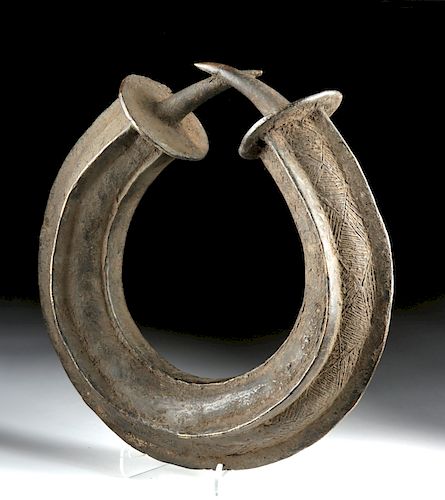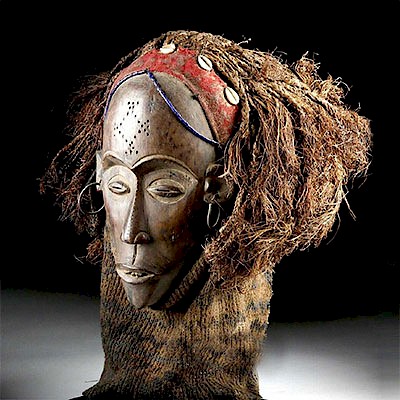Large 17th C. Yoruban Copper Alloy Currency Torque
Lot 102b
About Seller
Artemis Fine Arts
686 S Taylor Ave, Ste 106
Louisville, CO 80027
United States
Selling antiquities, ancient and ethnographic art online since 1993, Artemis Gallery specializes in Classical Antiquities (Egyptian, Greek, Roman, Near Eastern), Asian, Pre-Columbian, African / Tribal / Oceanographic art. Our extensive inventory includes pottery, stone, metal, wood, glass and textil...Read more
Estimate:
$500 - $700
Absentee vs Live bid
Two ways to bid:
- Leave a max absentee bid and the platform will bid on your behalf up to your maximum bid during the live auction.
- Bid live during the auction and your bids will be submitted real-time to the auctioneer.
Bid Increments
| Price | Bid Increment |
|---|---|
| $0 | $25 |
| $300 | $50 |
| $1,000 | $100 |
| $2,000 | $250 |
| $5,000 | $500 |
| $10,000 | $1,000 |
| $20,000 | $2,500 |
| $50,000 | $5,000 |
| $100,000 | $10,000 |
| $200,000 | $20,000 |
About Auction
By Artemis Fine Arts
Apr 4, 2019
Set Reminder
2019-04-04 10:00:00
2019-04-04 10:00:00
America/New_York
Bidsquare
Bidsquare : Ancient / Ethnographic From Around The World
https://www.bidsquare.com/auctions/artemis-gallery/ancient-ethnographic-from-around-the-world-4003
Ancient art from Egypt, Greece, Italy and the Near East, as well as Asian, Pre-Columbian, Native American, African / Tribal / Oceanic, Spanish Colonial, Russian Icons, Fine art, much more! All categories, all price ranges... all legally acquired and guaranteed to be as described or your money back Artemis Fine Arts info@artemisgallery.com
Ancient art from Egypt, Greece, Italy and the Near East, as well as Asian, Pre-Columbian, Native American, African / Tribal / Oceanic, Spanish Colonial, Russian Icons, Fine art, much more! All categories, all price ranges... all legally acquired and guaranteed to be as described or your money back Artemis Fine Arts info@artemisgallery.com
- Lot Description
Africa, Nigeria/Republic of Benin, Yoruba, ca. late 19th to early 20th century CE. A sizeable and quite hefty copper alloy currency torque - the metal possibly extracted from manillas, which were also a source of metal for royal heads and plaques that have been created since the 16th century in Benin - presenting a beautiful surface with a cross-hatched/weave-like pattern and marvelous rich age patina. Size: 13.25" L x 13" W (33.7 cm x 33 cm); weight: 19 pounds (8.6 kilograms)
See a similar example dating to 17th to 18th century at the Virginia Museum of Fine Arts (object number 2014.12) - https://www.vmfa.museum/piction/6027262-10401737/
The curatorial staff wrote, "Given the scarcity of copper ore in western Africa, the metal was a highly prized commodity attained through trade with Europe or from other distant parts of Africa, such as Morocco to the north and Katanga in the Congo. When European ships started arriving along the African coast in great numbers during the 16th century and later, they carried brass (an alloy of copper) manillas, bracelet-shaped weights in different sizes that served as a medium of exchange. The Yoruba melted them down and recast perhaps twenty or so into larger currencies, or torques."
Provenance: private New York, New York, USA collection
All items legal to buy/sell under U.S. Statute covering cultural patrimony Code 2600, CHAPTER 14, and are guaranteed to be as described or your money back.
A Certificate of Authenticity will accompany all winning bids.
We ship worldwide and handle all shipping in-house for your convenience.
#143251Nicks to peripheries. Expected surface wear commensurate with age. Gorgeous deep patina.Condition
- Shipping Info
-
All shipping is handled in-house for your convenience. Your invoice from Artemis Gallery will include shipping calculation instructions. If in doubt, please inquire BEFORE bidding for estimated shipping costs for individual items.
-
- Buyer's Premium



 EUR
EUR CAD
CAD AUD
AUD GBP
GBP MXN
MXN HKD
HKD CNY
CNY MYR
MYR SEK
SEK SGD
SGD CHF
CHF THB
THB














